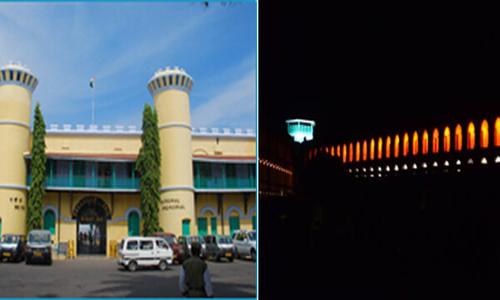- 10 LS Street , Haddo, Port Blair, Andaman and Nicobar Islands
CELLULAR JAIL

CELLULAR JAIL
The Cellular Jail was known to house many notable Indian activists during the Indian freedom struggle. The Jail is one of the murkiest chapters in the history of British rule in India. The construction of the prison started in 1896 and it took 10 years for completion. The bricks used to build the building were brought from Burma, erstwhile Myanmar.
NATIONAL MEMORIAL CELLULAR JAIL
But the history of using the Andaman island as a prisoner’s colony dates back to the Indian rebellion of 1857. Lt. Archibald Blair had surveyed the islands in the year 1688. So immediately after the first revolt of 1857, the freedom fighters were sent here and used as laborers for construction of the jail as well as for the buildings in Ross Island which were established as the administrative headquarter and residential area for the British Officers.
Cellular jail is situated in the heart of the city and is just 2 km away from the main Aberdeen Bazaar and 6 Kms from the airport. It is the first point of visit for most tourists visiting Andamans.
Cellular Jail remains open for visitors on all days from 9 am to 5 pm but the entry gate will be closed at 4 pm.
Some history about the Cellular Jail
On March 10, 1858, James Peterson Walker, the Superintendent of the Penal Settlement, landed in Andaman with the first batch of 200-chained prisoners, who were in fact our first freedom fighters. They had raised the banner of revolt against the foreign domination in India during the First War of Indian Independence in 1857. Within three months the number of prisoners increased to 773.
The penal settlement established in the Andaman Islands after the First War of Independence in 1857 was the beginning of the agonizing story of Indian freedom fighters in the makeshift and awful jails at Viper Island followed by the Cellular Jail. The patriots who raised their voice against the Britishers were sent to this Jail, many of them returned to their homes after completion of their punishment, but most of them could not.
Every wall of the Cellular jail has got a heart-rendering story of struggling, sufferings, and sacrifices.
Construction of the cellular Jail
The jail was constructed on 3 floors with 7 wings, Each wing stretching from Central tower similar to spokes of a wheel. There was also an entrance block to the jail which housed all the administrative offices. It had 696 cells, one for each person. The name Cellular Jail is derived from its unique feature as it has only cells, unlike other jails which had dormitories. Each cell measured 13.5 feet by 7 feet and had iron bar doors in the front. A small ventilator, nearly 10 feet high was the only source of light and air in the cells.
Due to some political reasons, 04 out of the 07 wings of the Cellular Jail were demolished after Independence. It was only after a huge protest by the freedom fighters who had spent their lives in the jail, the demolition was stopped and the Cellular Jail was declared as a national memorial.
Cellular Jail has now been declared as a National Memorial and is open for tourists. The Jail has a museum depicting the life of the convicts, the dress, utensils, and the instruments used by them. There is a gallery of photographs of the inmates. The gallows where the inmates were hanged to death should not be missed.
Visiting Timing : 9.00 AM To 4.00 PM
Note : Cellular Jail is closed on Monday and Public Holidays.





